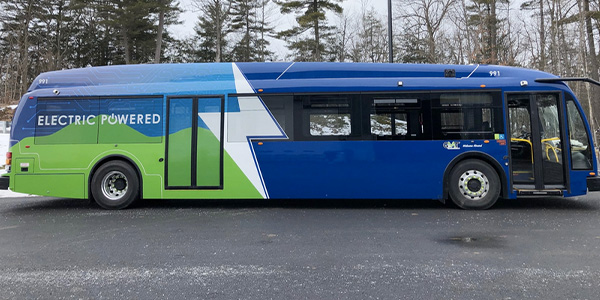[contact-form][contact-field label=”Name” type=”name” required=”true” /][contact-field label=”Email” type=”email” required=”true” /][contact-field label=”Website” type=”url” /][contact-field label=”Message” type=”textarea” /][/contact-form]More than 200 people joined the annual two-day Energy Action Network (EAN) Summit online last week to hear ideas on how to tackle some of the clean energy challenges facing the mostly rural Vermont, including increasing bus ridership and incentivizing more fuel-efficient cars.
EAN comprises more than 200 nonprofits, businesses, public agencies and other organizations advocating for clean energy. Following is some of what we heard at the meeting.
‘Cultural War’
State Sen. Andrew Perchlik spoke about his proposed vehicle “feebate” program aimed at people buying new vehicles. It would provide a rebate if the vehicle has a mileage rating above average for its vehicle class and add a fee on the purchase if it is below average. House Bill 529, signed into law last year, called for a study of the proposal, which Perchlik said would be self-funding program and revenue-neutral for the state.
The electric Chevy Bolt, which gets 118 mpg equivalent, would be worth a $1,000 rebate, under the program he said.
“But if you really wanted a Cadillac CT5 that only gets 21 mpg, that price would be adjusted up $500. … In a truck example, if you wanted the Ford F-150 Raptor four-wheel drive that only gets 16 mpg, you would pay $250 more for that vehicle,” Perchlik said.
“We would adjust accordingly… to make sure that it’s meeting its goal of causing people to buy more efficient vehicles,” Perchlik said. “We also don’t want to make the penalty so large … that it creates a lot of pushback, especially as we’re just rolling out the program.”
He said the program has been implemented in Ontario but not in the U.S. “Part of the reason is that you get into a cultural war of truck owners not wanting to support Prius owners, for example.”
Junk the Clunker, Go Electric
Sue Minter, executive director of Capstone Community Action, a social advocacy organization, and EAN Senior Fellow Linda McGinnis promoted a “Replace Your Ride” program modeled on one in California to provide cash incentives to low-income Vermonters to trade in their older high-polluting vehicles for a range of clean transportation and shared-mobility options.
Jennifer Wallace-Brodeur of the Vermont Energy Investment Corp. (VEIC), a nonprofit organization that advocates for energy efficiency and renewable energy, joined Cara Robechek of the Vermont Energy Education Program (VEEP) and Peggy O’Neill-Vivanco of the University of Vermont to speak on combining and electrifying rural school and public transportation.
The Vermont Clean Cities Coalition at UVM is a transportation fuels resource for educators, consumers and providers of advanced transportation technologies.
An anonymous participant submitted a question about how the electric buses would handle the rough terrain that a lot of diesel- or natural gas-powered school buses cover in rural areas.
In 2017, Green Mountain Transit, Advance Transit and UVM demonstrated an electric transit bus to test out how it would do in winter conditions and a variety of routes. “We did find that there are different emission savings and fuel cost savings associated with different operating conditions. So, whether it be short routes in town with lots of stops and starts, or hilly routes, there’s definitely some pros and cons to all of that. Operating conditions do make a difference,” O’Neill-Vivanco said. (See Takeaways from the Zero Emission Bus Conference.)
Wallace-Brodeur said that buses can increase their power through regenerative braking when they’re going downhill.
“But they do draw on the battery a little bit more when you’re going up, so it’s a bit of a tradeoff there,” she said. “And we absolutely know that winter conditions will impact the range of battery electric buses. So that has to be factored in when you’re planning routes and the size of batteries and battery configuration.”
Analysts at UVM have found that all of the schools that are participating in the test could meet the needs of their daily school transportation routes, with an electric bus, despite the range decreases in winter, Robechek said.
Another question was how the program would overcome safety issues connected with merging school and public transit systems.
“In most of the world, and many cities in this country, school and public transit does take place on the same buses, including in Burlington, Vt., and it takes place on public buses, not on school buses,” Robechek said.
Nothing Beats a Free Ride
Jack Hanson of Sustainable Transportation Vermont (STVT) proposed that the state allocate $3 million out of the $641 million transportation budget for 2020 to fund fare-free transit, as a way to cut per capita emissions and enhance social justice.
“Vermont has a very serious problem of transportation emissions despite years of improvement, with nearly half of current emissions as a state coming from transportation. By far the largest share of those emissions is from our reliance on single-occupancy vehicles,” Hanson said.
Mass transit offers a drastic reduction in carbon emissions over single-occupancy vehicle gains, but it’s a challenge in a rural state to get people out of their cars and onto buses. Fare-free transit has proven effective in case studies around the world, he said.
For example, Advance Transit, which serves the Dartmouth area between Vermont and New Hampshire, saw a 76% increase in ridership in the first two years of fare-free transit and a nearly 300% increase since it was implemented in 2014. Green Mountain Transit, which serves the Burlington and Montpelier areas, projects that if fare-free was implemented under normal, non-pandemic conditions, it would see a 37% increase in ridership, Hanson said.
“So, who is currently paying transit fares in Vermont? Well, it’s the bus riders themselves, obviously,” Hanson said. “And this is a group of Vermonters that is disproportionately low-income and people of color. It’s a group that has some of the least impact on climate change … [and] many of these folks have limited mobility options.”





